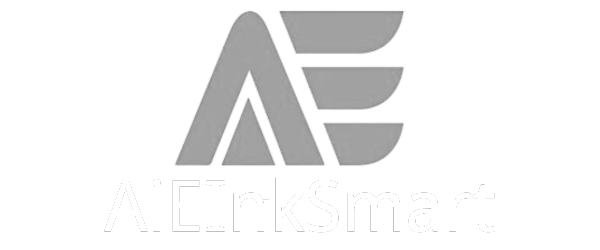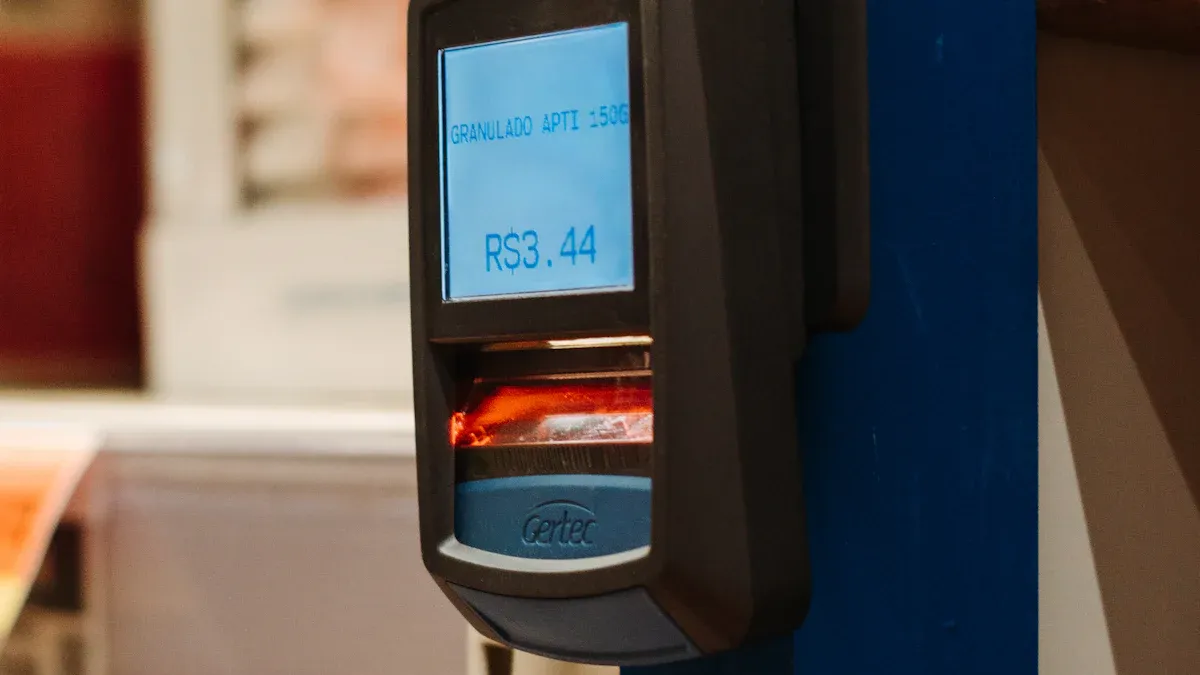
Digital price tags, also known as Electronic Shelf Labels, have transformed the retail environment. Retailers rely on an internet gateway to connect digital price tags with management systems for accurate price changes and inventory control. The ESL Gateway AP enables seamless integration, making real-time updates possible. Without this gateway, integration with systems like POS or ERP remains out of reach. Esl Retail operations benefit from reliable data flow between the ESL Price Tag and central software, ensuring consistency across the store.
Understanding Digital Price Tags and Integration
What Are Digital Price Tags (Electronic Shelf Labels)?
Digital price tags, often called electronic shelf labels (ESLs), have become a core technology in modern retail. These devices display product prices and information on store shelves, replacing traditional paper tags. Retailers use ESLs to automate price changes and improve price synchronization across all store locations.
Key Features of Electronic Shelf Labels
| Feature | Electronic Shelf Labels (ESLs) | RFID Labels | LED Labels |
|---|---|---|---|
| Display Capability | E-ink or LCD display | No display | LED screen |
| Communication Method | Wireless (RF, Bluetooth, Wi-Fi) | RFID readers | Wired/wireless |
| Main Functions | Real-time price updates, product info display | Inventory tracking | Alerts |
| Power Consumption | Low | Low-medium | High |
| Integration Requirements | Label management software, wireless networks, ERP/POS integration | RFID readers | Simpler function |
| Ideal Use Cases | Retail stores, pharmacies | Warehousing | Promotions |
Electronic shelf labels use energy-efficient e-ink or LCD screens. They connect wirelessly to a label management system, which acts as the command center for all ESLs in the store. This system enables real-time pricing and product information updates. Retailers can manage thousands of ESLs from a single dashboard, ensuring price synchronization and reducing manual labor.
Benefits for Retailers
Retailers gain several advantages by adopting electronic shelf labels:
- Automated price changes reduce human error and labor costs.
- Price synchronization across all shelves ensures customers see accurate prices.
- Real-time updates allow stores to respond quickly to market trends and competitor pricing.
- The label management system supports complex pricing strategies, such as demand-based or promotional pricing.
- ESLs help retailers maintain compliance with pricing regulations.
Note: Some ESL providers design their systems to work with third-party label management software, making integration with existing retail systems more flexible.
The Importance of Integration in Retail Environments
Real-Time Price Updates
Integration between ESLs and retail management systems enables real-time price updates. The label management system receives pricing data from the central database and pushes updates instantly to every electronic shelf label. This process ensures that price synchronization occurs throughout the store, even during high-traffic periods or promotional events. Real-time pricing helps retailers stay competitive and avoid pricing discrepancies.
Synchronization with Retail Systems
Price synchronization depends on seamless integration between ESLs, POS, ERP, and inventory systems. The label management system acts as a bridge, connecting digital price tags to all relevant retail software. This setup allows for centralized control of pricing, inventory, and product information. Retailers can implement price changes across multiple locations with a single command, reducing the risk of errors and improving operational efficiency.
Retailers face several challenges during integration:
- High initial investment for hardware and software.
- Technical complexity when connecting ESLs to existing systems.
- Ensuring reliable wireless connectivity in large stores.
- Need for specialized technical expertise for installation and maintenance.
Innovations such as open APIs, cloud-based platforms, and advanced wireless protocols help address these challenges. Modular systems and subscription pricing models also make ESL adoption more accessible for retailers of all sizes.
The Role of the Internet Gateway in Digital Price Tag Integration
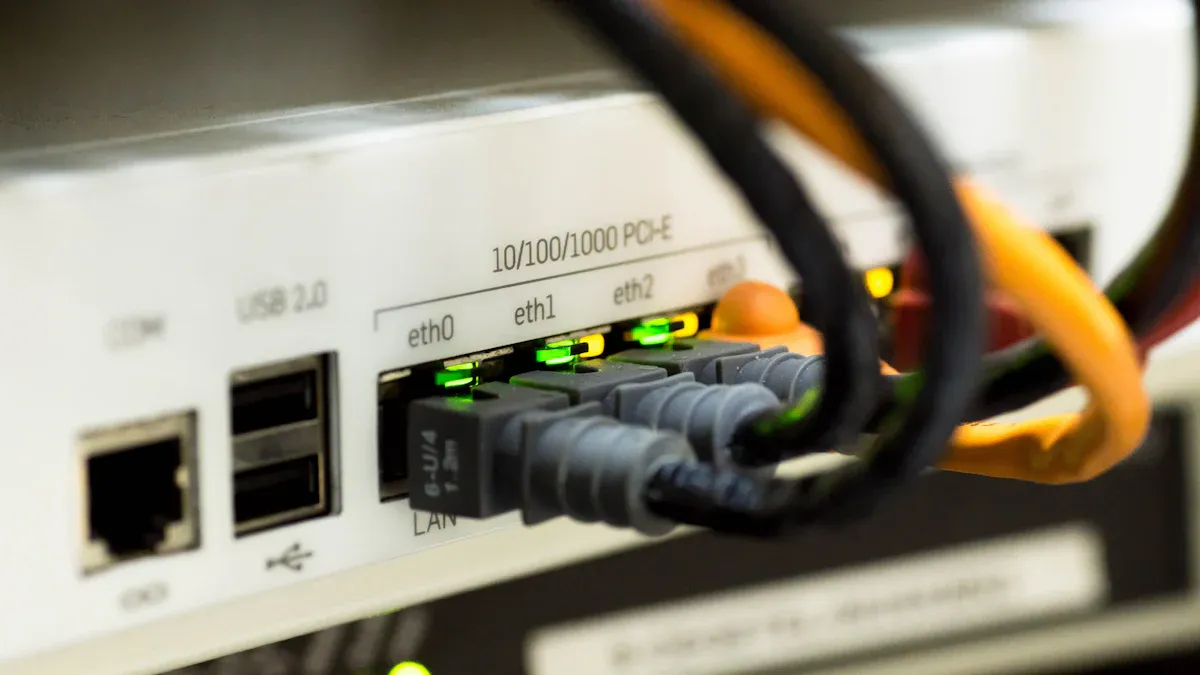
What Is an Internet Gateway?
Definition and Core Functions
An internet gateway serves as the central communication hub between electronic shelf labels and a retailer’s management systems. This device receives commands from the store’s central server or cloud platform and transmits them wirelessly to each ESL. The gateway manages all data transfer, ensuring that every label receives accurate and timely updates. Retailers depend on this device to maintain real-time pricing, synchronize inventory information, and automate promotions.
The technical specifications of a typical gateway for electronic shelf labels highlight its robust capabilities:
| Specification Category | Details |
|---|---|
| Materials | ABS |
| Weight | 0.8 kg |
| Dimensions | 200mm x 127mm x 31mm |
| Update Speed | 24,000 labels per hour |
| Labels Supported | Up to 65,000 labels per gateway |
| Communication Protocol | Customized |
| Processing Element | ARM |
| Network Connector | RJ45 |
| Wireless Transmission Power | 15 dBm to 27.5 dBm |
| Frequency Spectrum | 433 MHz to 434 MHz |
| Communication Rate | Up to 175 kbps |
| Communication Distance | Up to 50 meters diameter without obstacles |
| Interface | TCP/IP via Ethernet cable or WiFi |
| Control UI | Multiple stations controlled via internet or LAN |
| Communication Model | Bidirectional data communication |
| System Failure Rate | Less than 0.1 per thousand |
| Power Requirements | DC 5V input or Power over Ethernet (PoE) supported |
| Operating Conditions | Temperature: 0°C to 50°C (operation), -20°C to 70°C (storage); Humidity < 75% |
| Key Features | Hardware/software encryption for RF data security, low RF error rate, alarm functions |
This table demonstrates the gateway’s ability to support thousands of ESLs, maintain high-speed updates, and operate reliably in demanding retail environments.
How the Gateway Connects to Digital Price Tags
The gateway connects to digital price tags using wireless protocols such as RF, Bluetooth, or WiFi. It acts as an access point, bridging the gap between the store’s network and each ESL on the shelves. The device receives data from the central management system through a wired or wireless network connection. It then transmits this information to the ESLs within its coverage area, which can reach up to 50 meters in diameter without obstacles.
Retailers often deploy multiple gateways to cover large stores or multi-floor layouts. Each gateway manages a specific group of electronic shelf labels, ensuring that data transfer remains efficient and reliable. The system’s bidirectional communication model allows ESLs to confirm receipt of updates, further improving accuracy and reducing errors.
Why the Internet Gateway Is Essential for Electronic Shelf Labels
Data Transmission and Communication Protocols
The internet gateway plays a critical role in managing data transfer between the central management software and ESLs. It supports customized communication protocols designed for stability, speed, and low power consumption. These protocols enable real-time updates, allowing retailers to change prices, update promotions, or adjust inventory information instantly across thousands of electronic shelf labels.
Gateways typically operate in frequency bands such as 433 MHz or 2.4 GHz, which provide strong anti-interference capabilities and reliable connections in busy retail environments. The hardware and software encryption features protect sensitive pricing and inventory data during transmission. This secure communication ensures that only authorized devices can interact with the ESL system.
Note: Reliable data transfer is essential for dynamic pricing, automation, and enhanced customer experiences in modern retail stores.
Managing Large Numbers of Digital Price Tags
Retailers often deploy thousands of ESLs in a single location. The gateway’s ability to support up to 65,000 labels per device makes large-scale integration possible. This scalability allows stores to expand their digital price tag systems as needed, without major infrastructure changes.
The gateway also simplifies maintenance and reduces downtime. Staff can manage and monitor all ESLs from a central dashboard, making it easy to identify and resolve issues quickly. Some systems even allow staff to update individual labels using a smartphone app, providing flexibility and efficiency.
- Key benefits of using an internet gateway for ESLs include:
- Real-time connection to the retailer’s network for instant updates.
- Seamless integration with cloud-based systems and other IoT devices.
- Unified connectivity layer that reduces hardware requirements.
- Lower total cost of ownership and simplified maintenance.
- Enhanced reliability and scalability for growing retail operations.
The combination of robust hardware, advanced communication protocols, and centralized management makes the internet gateway indispensable for electronic shelf label integration. Retailers gain the ability to automate pricing, improve inventory accuracy, and deliver a consistent customer experience across all locations.
How Digital Price Tags Communicate Through the Internet Gateway
Communication Flow Between Management Software and ESLs
Step-by-Step Data Transfer Process
A typical electronic shelf label system relies on a structured communication flow to ensure accurate and efficient updates. The process begins with the label management system, which operates as a centralized platform for configuring product information and pricing. Users access this system through a web-based content management interface, eliminating the need for specialized applications. The central management system packages the necessary data and prepares it for transmission.
The internet gateway, often called a communication module or base station, acts as the bridge between the management software and the ESLs. The gateway receives the packaged data and transmits it wirelessly to the electronic shelf labels throughout the retail environment. Each ESL receives, processes, and displays the updated information on its screen. This process supports two-way communication, allowing ESLs to send status updates or error reports back to the management system.
The hardware setup, including the gateway and ESLs, supports stable wireless communication, enabling efficient product information flow from the management software to the shelf.
The following steps summarize the data transfer process:
- The label management system processes and organizes product and pricing data.
- The gateway transmits this data wirelessly to the appropriate ESLs.
- ESLs receive and display the new information.
- ESLs can send feedback or status updates to the management system.
Ensuring Real-Time and Accurate Updates
Retailers require real-time updates to maintain accurate pricing and inventory management. Wireless communication technologies, such as Bluetooth and proprietary radio frequencies, enable rapid data transfer between the gateway and ESLs. Supermarkets and large retail stores can update thousands of prices within seconds or minutes, reducing manual labor and minimizing errors. This capability allows stores to implement price changes quickly, respond to market trends, and maintain compliance with pricing regulations.
Electronic shelf labels use advanced wireless protocols to ensure reliable and secure data transmission. The system’s two-way communication model verifies that each ESL receives the correct information, supporting seamless integration and reducing the risk of discrepancies.
Integration with POS, ERP, and Inventory Systems
Centralized Data Management
Integration with POS, ERP, and inventory management platforms is essential for modern retail operations. The central management system connects directly to these platforms, enabling automated data exchange. The internet gateway facilitates this process by acting as a communication bridge, ensuring that updates flow smoothly between the management software and the ESLs.
| Integration Aspect | Description |
|---|---|
| Data Flow | POS captures real-time transaction data and sends it to ERP for processing and updates. |
| Integration Methods | Native connectors, custom APIs, and middleware enable data synchronization and system linkage. |
| Role of Internet Gateway | Acts as a communication bridge, often cloud-based, facilitating real-time data exchange. |
| Synchronization Focus | Inventory levels, sales data, and order management remain consistent across platforms. |
This centralized approach streamlines inventory management, pricing, and sales tracking, allowing retailers to manage all store operations from a single dashboard.
Seamless Information Flow
A seamless integration strategy ensures that information moves efficiently between all retail systems. The cloud platform communicates with the internet gateway, which then connects to the electronic shelf labels. This setup enables real-time updates and synchronization of pricing, inventory, and sales data across the entire retail network.
- Digital price tag systems operate via a cloud platform.
- The cloud platform communicates through an internet gateway.
- The gateway connects to ESLs, enabling integration with POS and ERP systems.
Wireless communication protocols, such as Bluetooth, LoRa, and proprietary RF, support both short-range and long-range data transfer. This flexibility allows retailers to deploy ESLs in stores of any size, ensuring that every price change and inventory adjustment reaches the shelf without delay.
Alternatives to Using an Internet Gateway for Digital Price Tag Integration
Direct Integration Approaches
Cloud-Based Electronic Shelf Label Systems
Some retailers explore cloud-based electronic shelf label systems as an alternative to traditional gateways. These solutions connect ESLs directly to cloud servers using wireless protocols. The cloud platform manages pricing, inventory, and product data, pushing updates to each label over the store’s wireless network. This approach enables staff-free updates and remote management from any location. Retailers benefit from reduced on-site hardware and simplified maintenance. Cloud-based systems often leverage iot infrastructure, allowing seamless integration with other smart devices in the store. However, these systems depend heavily on stable wireless connectivity and robust cloud services to ensure consistent performance.
Wireless Access Points as Gateways
Wireless access points can sometimes serve as a substitute for dedicated gateways. In this setup, ESLs communicate with the store’s network through standard wireless access points, which relay data to the central management system. This method leverages existing wireless infrastructure, reducing the need for additional hardware. Retailers can integrate iot devices, including digital price tags, into their broader wireless ecosystem. While this approach simplifies deployment, it may introduce challenges related to network congestion and device compatibility. The effectiveness of wireless access points depends on their ability to handle large volumes of iot traffic and maintain reliable connections for all ESLs.
Limitations and Considerations of Alternative Architectures
Scalability and Reliability
Alternative architectures present unique challenges in scalability and reliability. Cloud-based API tools offer high scalability, allowing resources to adjust easily based on demand. These platforms provide high reliability through redundant infrastructure and managed maintenance. On-premises solutions, in contrast, limit scalability and rely on internal resources for reliability. API gateway-based systems enhance scalability by managing and distributing API requests across backend services. They improve reliability by isolating failing services and preventing overloads. Centralized traffic management and security features further support robust integration.
| Integration Method | Scalability | Reliability | Control & Maintenance | Additional Notes |
|---|---|---|---|---|
| Cloud-Based API Tools | High scalability; resources can be adjusted easily based on demand | High reliability due to robust, redundant infrastructure and managed maintenance | Maintenance handled by provider, reducing internal IT burden | Subscription pricing; accessible remotely; backup and disaster recovery in place |
| On-Premises Solutions | Limited scalability; depends on internal resources and infrastructure | Reliability depends on internal maintenance and updates | Full control over infrastructure and configuration; requires internal IT resources for upkeep | Higher upfront costs; better data sovereignty and compliance control |
| API Gateway-Based Systems | Enhance scalability by managing and distributing API requests across backend services | Improve reliability via features like circuit breaking to isolate failing services | Centralized traffic management, security, and observability | Enables horizontal scaling; prevents overload; complements other integration methods |
Security and Maintenance
Security and maintenance remain critical considerations for any integration architecture. Alternative systems, such as RFID with wireless sensor networks or LPWAN technologies, face technical and operational limitations. The following table summarizes these challenges:
| Architecture/Technology | Main Technical Limitations | Main Operational Limitations |
|---|---|---|
| RFID Integration with WSN | Limited communication range (few meters for RFID/NFC); single-hop communication constraints; limited processing and memory in sensor tags | Power consumption challenges in wireless communication; complexity in addressing and routing; scalability issues in mesh networks |
| LPWAN (e.g., Sigfox, NB-IoT) | Low data rates; message frequency limits; bandwidth constraints | Limited throughput for real-time data; energy constraints; operational cost considerations |
| Smart Gateways in IoT | Need for local data preprocessing; managing communication between heterogeneous devices; ensuring security and privacy | Complexity and cost of API gateway solutions; monitoring power consumption; operational overhead in maintaining distributed gateways |
| General IoT Communication | Addressing and identification challenges; need for low power protocols; routing protocols must be memory efficient; limited range of non-IP protocols | Limited range restricts application; complexity in integrating IP and non-IP networks; scalability and mobility management challenges |
Retailers must evaluate these factors when considering alternatives to internet gateways. Wireless solutions offer flexibility but may struggle with large-scale deployments. IoT integration introduces new security risks and maintenance demands. Each architecture presents trade-offs between convenience, performance, and operational complexity.
Tip: Retailers should assess their store size, wireless infrastructure, and iot device requirements before selecting an integration strategy.
Practical Implications for Retailers: Installation, Costs, and Integration
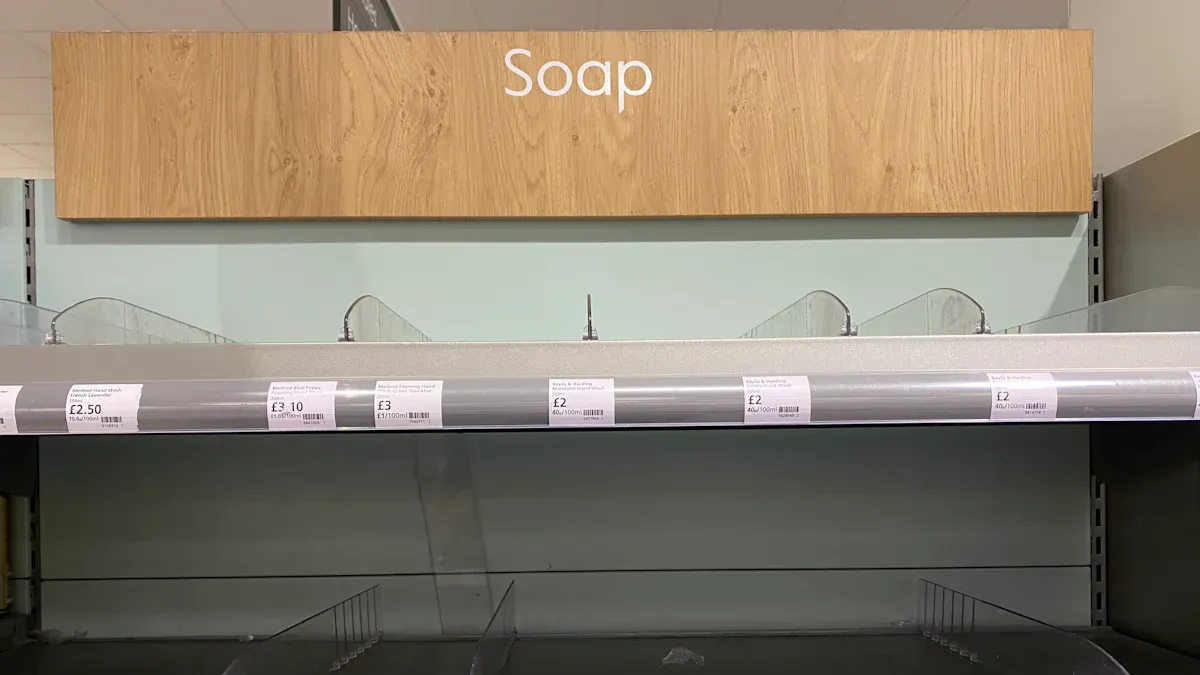
Installation Process for Digital Price Tags and Internet Gateways
Hardware and Network Requirements
Retailers planning to deploy digital price tags must first assess their hardware and network needs. Each store requires a sufficient number of electronic shelf labels, gateway hardware, and a reliable wireless network. The gateway hardware acts as the communication bridge between the central management system and the shelf labels. Most retail stores need multiple gateways to ensure full coverage, especially in larger spaces. A robust Wi-Fi or RF network supports stable data transmission, while the store’s IT infrastructure must handle increased device traffic.
Store Setup and Activation Steps
The installation process begins with mapping the store layout to determine optimal gateway placement. Technicians attach digital price tags to shelves and connect the gateway hardware to the store’s network. After physical setup, staff activate the system through the management software, linking each label to its corresponding product. Testing follows, ensuring every label receives updates and displays accurate information. Staff training on software use and troubleshooting completes the setup, preparing the team for daily operations.
Cost Factors in Digital Price Tag Integration
Upfront Investment in Gateways and ESLs
Initial costs for digital price tag integration include purchasing ESL units, gateway hardware, and software licenses. The following table outlines typical expenses:
| Cost Factor | Estimated Cost / Description |
|---|---|
| Electronic Shelf Label (ESL) Unit | $5 to $10 per label |
| Gateway Hardware | Around $1,200 for 3-4 gateways (for ~1,000 sqm retail space) |
| Software Maintenance Fee | Approximately $500 annually |
| Total Upfront Cost (10,000 tags) | Between $60,000 and $100,000 |
Retailers should also budget for installation labor and staff training. Integration with legacy POS systems may require middleware or custom development, increasing upfront costs.
Ongoing Maintenance and Support
Ongoing expenses include software maintenance, technical support, and battery replacement. E-ink tags offer up to five years of battery life, reducing frequent replacements. Annual technical support fees typically range from $1,000 to $3,000, covering software updates and infrastructure maintenance. Over a five-year period, e-ink tags often result in lower total costs compared to LCD tags, which require more frequent battery changes and repairs.
Tip: Retailers can expect a payback period of one to three years, depending on store size and operational efficiency.
Integrating Digital Price Tags with Existing Retail Systems
Compatibility with POS and ERP Solutions
Integrating digital price tags with existing POS and ERP systems presents several challenges. Legacy POS systems may lack modern API support, requiring software upgrades or middleware to enable connectivity. Hardware limitations in older checkout stations can prevent real-time price syncing. Many older systems do not support cloud-based synchronization, which is common in modern ESL solutions. Retailers often use middleware to bridge these gaps and ensure seamless integration.
Best practices for integration include:
- Selecting ESL platforms with compatible APIs.
- Using phased rollouts to minimize disruption.
- Maintaining data accuracy with bi-directional synchronization and automated validation.
- Applying security measures such as encryption and multi-factor authentication.
IT Support and Staff Training
Successful integration depends on strong IT support and comprehensive staff training. Retailers should engage IT, operations, and inventory teams early in the process. Training covers system operation, troubleshooting, and security protocols. Ongoing education ensures staff can adapt to software updates and new features, maintaining smooth retail operations.
Note: Reliable wireless infrastructure and vendor support are essential for long-term success.
Choosing the Right Internet Gateway and Integration Strategy
Key Factors for Retailers to Consider
Store Size and Layout
Store size and layout play a crucial role in selecting the right internet gateway and integration strategy for digital price tags. Large stores, such as warehouse clubs or discount retailers, often require bigger ESL screens—ranging from 7.4 to 12.2 inches—to ensure visibility across wide aisles and open spaces. These larger screens support bulk items and high product volumes. Standard shelving in mid-sized stores benefits from screens between 4.2 and 7 inches, balancing information density and shelf space. Specialty or smaller stores may prefer mid-large or graphic ESL screens to enhance customer engagement and provide detailed product information.
Durability and wireless connectivity become essential in larger, fast-paced environments. Robust casings, anti-glare coatings, and long battery life help maintain performance. Store layout also affects mounting choices. Retailers must evaluate magnetic mounts, clip-on holders, or adhesive strips to ensure secure placement and maintain store aesthetics.
| Store Area/Display Type | Recommended ESL Screen Size | Key Benefits |
|---|---|---|
| Bulk Pallet Displays | 7.4 – 12.2 inches | High visibility, supports large fonts |
| End Caps/Feature Areas | 7.4 – 10 inches | Eye-catching promotions, multi-line info |
| Standard Shelving | 4.2 – 7 inches | Balanced info, supports barcodes/QR codes |
| Clearance Bins | 4.2 – 5.8 inches | Quick price changes, clear markdowns |
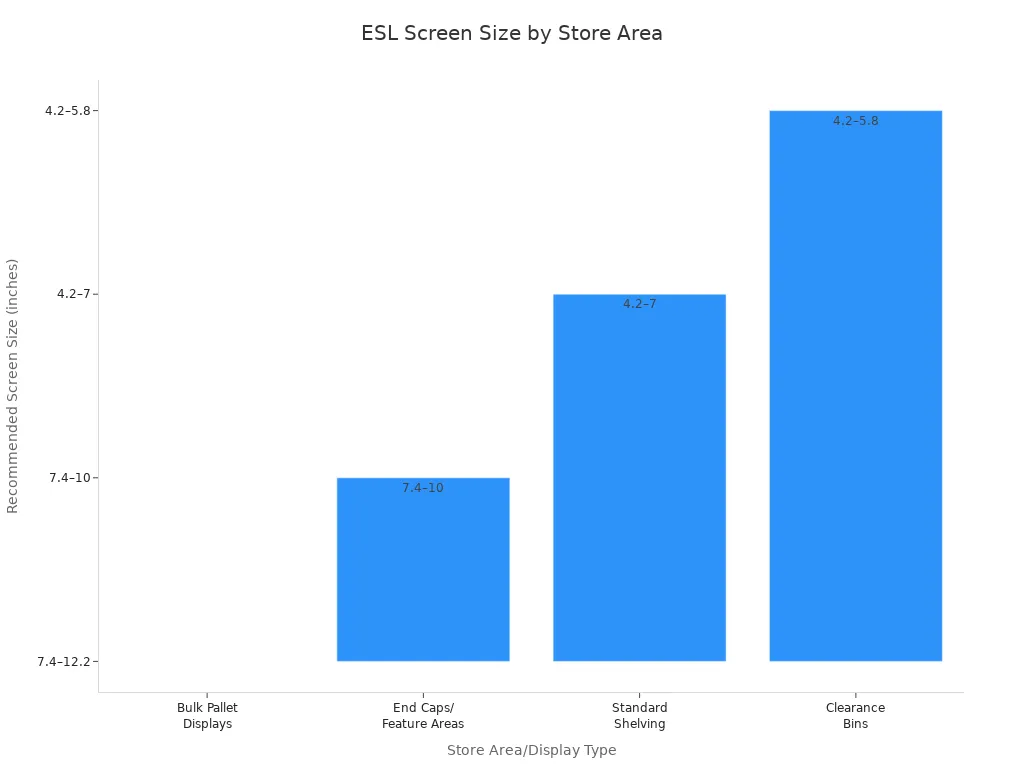
Number of Digital Price Tags Needed
The total number of digital price tags required directly impacts the choice of gateway. Large retail environments may deploy thousands of ESLs, demanding gateways that support high device counts and wide coverage. Smaller stores can operate with fewer gateways and simpler integration. Scalability remains a key consideration, as future expansion may require additional gateways or upgraded infrastructure.
Evaluating Gateway and Vendor Options
Performance and Reliability
Retailers must evaluate several criteria when selecting a gateway and vendor. Performance and reliability stand at the top of the list. Gateways should support seamless, real-time updates and maintain stable wireless connections, even in high-traffic environments. Battery life, ease of installation, and maintenance requirements also influence long-term success. Retailers often look for systems that offer:
- In-store optimization for employee efficiency.
- Scalability from pilot to full deployment.
- Future-proof features, such as geolocation.
- Compatibility with inventory and POS systems.
- Strong ROI, factoring in battery replacement and maintenance costs.
- Compliance with pricing accuracy laws.
- Security certifications and robust data protection.
- Flexible label sizes and color options.
- Support for complex messages and multiple colors.
- Long battery life across suppliers.
Tip: User-friendly interfaces and flexible update options help staff manage prices and promotions efficiently.
Support and Service Agreements
Vendor support and service agreements provide essential reliability for digital price tag deployments. Most vendors offer tiered support programs, each with specific response times and hardware replacement policies.
| Support Level | Response Time for Severity 1 Issues | Onsite Engineer Availability | Hardware Replacement (RMA) | Access to Knowledge Base |
|---|---|---|---|---|
| Standard | 30 minutes | No | Same business day shipment | Advanced |
| Premium | 30 minutes | No | Same business day shipment | Expert |
| Elite | 30 minutes | Yes (Emergency dispatch within 4 hours) | Same business day shipment | Expert |
| Diamond | 30 minutes | Yes (Based on support level) | Same business day shipment | Expert |
Service Level Agreements (SLAs) guarantee uptime, rapid response, and hardware support. These agreements ensure that retail operations remain uninterrupted and that any technical issues receive prompt attention. SLAs also outline warranties, penalties for missed targets, and access to expert knowledge bases, supporting continuous improvement and compliance.
Future Trends in Digital Price Tag Integration and Internet Gateways
Advances in Gateway Technology for Electronic Shelf Labels
Improved Connectivity and Speed
Recent advances in gateway technology have transformed the integration of IoT within smart retail environments. The adoption of the Bluetooth Electronic Shelf Label Profile, based on Bluetooth Core 5.4, enables scalable, ultra-low power, and highly secure wireless communication. This standardization supports multi-vendor interoperability, which lowers costs and accelerates innovation. Retailers now benefit from real-time price updates, with some reporting an 80% reduction in time spent on pricing updates and a 2-5% increase in sales after implementing electronic shelf labels. These improvements allow for dynamic pricing strategies, ensuring price consistency between shelf displays and points-of-sale.
- Bluetooth-enabled gateways support billions of devices, leveraging economies of scale.
- ESL devices now offer battery life of 7-10 years and durability with IP67 water and dust resistance.
- Programmable background colors and dual-button functionality enhance usability and responsiveness.
The integration of IoT with these advanced gateways streamlines inventory management and supports operational efficiency in both retail and healthcare settings.
Enhanced Security Features
Security remains a top priority in the integration of IoT for smart retail. Modern digital price tags incorporate sensors that alert staff to unexpected product movement and prevent unauthorized price changes. These tags work alongside store security systems, locking prices and detecting theft or inconsistencies. Enhanced security features increase the reliability and flexibility of digital price tags, making them more attractive for retailers. Integration with IoT and store analytics platforms provides valuable data on shopper behavior and inventory management, supporting dynamic pricing and personalized engagement.
Note: The combination of improved connectivity and robust security features positions digital price tags as a standard tool in smart retail environments.
Emerging Alternatives and Smart Retail Solutions
IoT and Edge Computing Integration
The integration of IoT and edge computing is reshaping the future of digital price tag systems. Edge computing processes data locally near IoT devices, reducing latency and enabling real-time responses. This approach optimizes bandwidth by filtering data locally and sending only essential information to central servers. Security improves as sensitive data remains within local networks, reducing risks during transmission. Retailers can implement dynamic pricing and personalized shopping experiences through faster data analysis. Efficient inventory tracking and management become possible as data processing accelerates at the edge.
- IoT-connected digital price tags act as data nodes within the smart retail ecosystem.
- These tags enable real-time pricing updates and support dynamic pricing strategies based on demand and inventory.
- Integration of IoT enhances customer engagement by providing additional product information and personalized experiences.
- Automation of pricing updates and shelf audits increases operational efficiency and reduces errors.
Next-Generation Digital Price Tag Systems
Smart retail environments are moving toward distributed Wi-Fi models that deploy enterprise access points or pods throughout stores. This mesh networking architecture supports multiple wireless standards, including Wi-Fi, cellular, Zigbee, Bluetooth LE, Thread, and UWB. Such systems enable seamless coverage and high data rates, tailored for IoT devices and sensors. Coordination among different protocols and the use of specialized filters address coexistence and interference challenges. Futureproofed RF components ensure longevity and adaptability, marking a shift from traditional centralized gateways to distributed, multi-standard connectivity solutions.
Tip: Retailers should monitor developments in the integration of IoT and edge computing to stay ahead in smart retail innovation.
Internet gateways play a vital role in connecting digital price tags with retail management systems. Large retailers benefit most from real-time price updates, operational efficiency, and improved customer engagement. However, high upfront costs, ongoing maintenance, and technical requirements can challenge smaller stores.
- Key benefits include:
- Accurate, dynamic pricing
- Reduced labor costs
- Enhanced customer experience
- Better inventory management
Retailers should evaluate store size, pricing needs, and technical resources before investing to ensure long-term success.
FAQ
What is the main function of an internet gateway in digital price tag systems?
The internet gateway acts as a bridge between the store’s management software and electronic shelf labels. It transmits pricing and product data wirelessly, ensuring real-time updates and synchronization across all shelf labels.
Can retailers use digital price tags without a gateway?
Most digital price tag systems require a gateway for integration. Some cloud-based solutions offer direct connectivity, but these often depend on robust wireless infrastructure and may have limitations in scalability and reliability.
How many digital price tags can a single gateway support?
A standard gateway can support thousands of electronic shelf labels. Some models manage up to 65,000 tags per device, making them suitable for large retail environments with extensive product ranges.
Are digital price tags secure from hacking or tampering?
Modern digital price tag systems use encryption and secure communication protocols. These features protect pricing data and prevent unauthorized access or tampering with shelf labels.
What happens if the internet connection fails?
Most gateways store recent updates locally. If the internet connection drops, the system continues to display the last received prices. Updates resume automatically once connectivity restores.
How long do digital price tag batteries last?
E-ink digital price tags typically offer battery life between five and ten years. Battery longevity depends on update frequency, display size, and environmental conditions.
What are the main costs involved in deploying digital price tags?
Retailers invest in electronic shelf labels, gateway hardware, software licenses, and installation. Ongoing costs include software maintenance, technical support, and battery replacement. The total cost varies by store size and system complexity.


